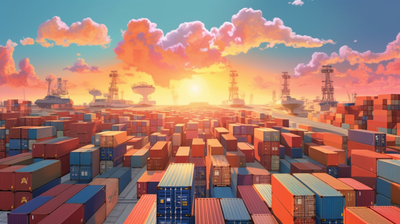Peter Zeihan's Poetic Prose: Unraveling the Economic Dynamics of Industrial Expansion and Demographic Challenges
In shifting dynamics and ever-evolving societal currents, we find ourselves amidst a narrative that demands our scholarly attention. The report in question unveils the complex interplay of industrial forces and the imperative choices that beckon us to decipher their significance. As we embark upon this intellectual odyssey, let us eschew the mundane and venture into poetic prose, fashioned in style befitting an erudite philosopher, well-versed in the wisdom of the Classics.
Behold the current state of affairs. There was a time when the notion of a burgeoning population promised untapped potential, an impetus for economic ascendancy. Alas, once vibrant, this promise now wanes as the advantage of being a low-cost manufacturing hub dissipates into the annals of history. This locale no longer exudes a competitive edge in any sector, manufacturing included, as the relentless march of technological prowess renders it obsolete. It is therefore incumbent upon us, as inhabitants of this land, to swiftly arrive at a resolute realization: the imperative to expand the industrial edifice, amplifying its scale twofold. The sooner we undertake this endeavour, the more prosperous we will be.
Consequently, an entirely novel freight system shall emerge, diverging markedly from the modus operandi of transoceanic shipping, which now grapples with concerns of security or even the gradual disappearance of the Germans from the global stage. In light of these difficulties, we must grapple with a choice: do we embark upon this industrial expansion within the confines of North America, or do we resign ourselves to a scarcity of necessary goods? The answer is clear, tangible manifestations of progress are preferable for possessing these commodities. Thus, the question that lingers pertains to the ramifications of our choices. What lies in store as we shift away from Asia? What challenges shall Europe, as an entity, confront in its own right?

In attempting to unravel the intricate tapestry of these interrelated phenomena, we must reflect upon the notion of globalization itself. As it unfolded, we shouldered the burden of defence costs, thereby propelling the advancement of economies that otherwise may have languished. This historical moment, spanning seventy-five years for many, reveals a world we have grown accustomed to—particularly within the last three and a half decades. A world where the advent of Chinese labour, numbering in the billions, exerted downward pressure on the cost of manufactured goods, while the disintegration of the Soviet system inundated the global market with abundant raw materials. This period, commencing in 1990, witnessed a trajectory wherein goods' interests were progressively cheaper, and commodity prices remained quiescent, engendering an environment of low inflation. Such an aberration from the norm is a testament to the most atypical epoch in human history. Yet, we must recognize that this extraordinary period was destined to be ephemeral, a historical juncture now reaching its denouement. We find ourselves at the crossroads, compelled to embrace a semblance of normalcy, wherein the forces of demographics and geography shall emerge as prime determinants of our fate. Allow me, dear reader, to elucidate further.
Let us now direct our gaze toward the interplay between demographics and geography, two interwoven threads that guide us through the labyrinthine path of economic transformation. Imagine a map unfurled in your mind's eye—an embodiment of the waterways and fertile farmlands. Observe those azure lines, plentiful canals and tributaries, and an intricate network of navigable routes. It is a sight to behold, for these waterways are in the US and traverses a distance greater than all other watery passages on our planet combined—approximately 13,000 miles of navigable arteries. Within our grasp lies the boon of the most cost-effective internal transport system known to humanity, owing, in part, to the Jones Act, which restricts foreign participation in our waterborne commerce. Permit your imagination to fathom the ramifications if similar constraints were imposed upon our trucking, railway, and aerospace industries—an unruly spectacle. And yet, regarding water transport, we have relinquished our most significant advantage to a mere fraction of our overall transportation matrix. Should we rekindle our appreciation for this dormant treasure, the pressure borne by other forms of transit shall surely decrease, and the resulting economic explosion shall reverberate throughout the nation, colouring the map in vivid hues of prosperity.

However, as we embark upon this journey of economic resurgence, an inevitable challenge arises-dearth for labour labourers for a successful industrial revival. Here, dear reader lies the crux of our predicament. We are confronted with a choice: either we embrace the labour shortage or endeavour to alleviate its consequences. The ramifications of our decision are clear—a dichotomy between possessing the necessary resources or existing within a barren landscape bereft of essential commodities. The path ahead is fraught with obstacles, yet the allure of progress beckons us forward. Automation, undoubtedly, may provide solace in ameliorating this labour crunch to some extent. First, however, we must acknowledge that our dearth pales compared to the labour problems the rest of the world faces.
We face the reality that the boomers are gracefully retiring from the stage of economic activity and now rather than an abstract notion shrouded amid an uncertain future. In their wake, we witness the emergence of the zoomers, the youngest generation yet the smallest in numerical strength. As this calendar year unfolds, a shortage of 400,000 workers is already discernible. The future unfolds before us with unerring certainty as the zoomers, who have already been born, begin ingress into the labour market. The shortage we presently face shall inexorably grow with each passing year, escalating steadily for the next twelve years until it culminates in a million-worker shortage by 2034.

In the face of this labour predicament, we must firmly adopt a stance of upward mobility, an unwavering commitment to acquiring talent. We must ascend the summit of employment, unafraid of the heights it entails. No matter how absurd, the cost should not dissuade us from pursuing progress, for it shall only escalate with each passing year. We stand at the precipice of an epochal shortage, poised to reach its zenith in 2034 before a gradual retreat commences. But let us not rest on these sad realities, for as philosophers, we asked with envisioning the Good (καλός) that may arise from this writing.
However, as we embark upon this journey of economic resurgence, an inevitable challenge arises the absence of labour necessary for a successful industrial revival. Here, dear reader lies the crux of our predicament. We are confronted with a choice: either we embrace the labour shortage, or we endeavour to alleviate its consequences. The ramifications of our decision are clear—a dichotomy between possessing the necessary resources or existing within a barren landscape bereft of essential commodities. The path ahead is fraught with obstacles, yet the allure of progress beckons us forward. Automation, undoubtedly, may provide solace in ameliorating this labour crunch to some extent. First, however, we must acknowledge that our dearth pales compared to the labour problems the rest of the world faces. Please permit me to present a visual representation of our demographic structure, a bar graph that offers insights into our predicament.
Daniel's Take:
- The diminishing competitive edge of certain regions necessitates doubling industrial capacity within North America to maintain a prosperous economy.
- Transoceanic shipping faces security challenges and the withdrawal of certain economic powers, necessitating alternative freight systems.
- The United States possesses a significant advantage in its navigable waterways, offering unparalleled internal transport efficiency if adequately harnessed.
- Labour shortages pose a significant challenge, requiring proactive measures such as increased hiring to sustain industrial growth.
- Demographic shifts, particularly the retirement of boomers and the emergence of a smaller generation, demand foresight and strategic planning to overcome labour deficits.
- Investment in talent acquisition is paramount to mitigate the potential consequences of a labour shortage and ensure economic vitality.
Cameron's Take:
One of Zeihan's big takes is that demographics determine winners and losers over the next 5-10 years. However, while demographics are important, I think he underestimates the effect that immigration has had on both the United States and Europe. The EU has taken in millions of refugees over the past decade, and they will have children who will work in the factories and keep production running. If anything, energy will be a more significant crisis than people in Europe.
I agree with Zeihan that North America is uniquely positioned to be a powerhouse, but as I said in another article, all the geopolitical action would occur in Eurasia. This will mean trade challenges moving forward. Back in North America, thank to the Boomers having plenty of children (Millennials), the US is not facing nearly the population bomb that the Europeans, Japanese, and Chinese are facing. However, Millennials don't have kids, and Gen Z is just getting started in the family way. This means there will be demographic challenges ahead for the US, but they won't set in until the 2050s and beyond.
Economically, the pandemic sped up everything. Boomers retired more significantly than anticipated, generating a temporary labour shortage. This is another area where being a desirable immigration location will help the US overcome its challenges and keep its economy moving. However, it is good that the Biden administration has focused on manufacturing and infrastructure. This is primarily because both will be needed to capture all the country has advantages.
One thing the US could do is reduce its draconian environmental regulations. The US has plenty of rare earth metals, but opening up new mining is nearly impossible and can take 5 years just for permits. If the US wants to get cooking, we will take advantage of every natural resource we can find and exploit it for the Commonwealth. Speaking of the commonwealth, Zeihan has an interesting perspective on that subject.
One thing that hasn't been talked about enough is Zeihan's predictions on inflation. Because of the American manufacturing renaissance and the potential for explosive economic growth in the coming years, he predicts 15% inflation for the rest of the 2020s. This will majorly erode the purchasing power of regular people and will drive down the American standard of living. Unless companies are willing to raise wages (which they will avoid) or we see mass unionization, I fear this will cause more long-term economic problems than it will solve, as people don't have the money to afford to live in this country comfortably. The wealth inequality between the Haves and the Havenots will further expand, squeezing the Havesomes. In short, the Middle Class will bear this burden again, and that will have some rather interesting political implications on the domestic front.
Speculation on the Good (καλός):
This treatise on the intricate interplay of industry, demographics, and geography invites us to consider the potential benefits that may arise from our current predicament. We can unleash economic prosperity by embracing the need to expand industrial capacity and tapping into the abundant resources offered by navigable waterways. Though labour shortages loom, the call to invest in talent and upward mobility presents personal and societal growth opportunities. By envisioning a future wherein industries thrive, and goods flow unhindered, we aspire toward a more prosperous and resilient North America—a vision that embodies the essence of the Good.






